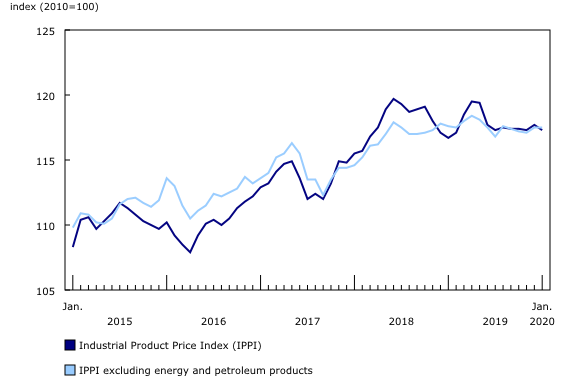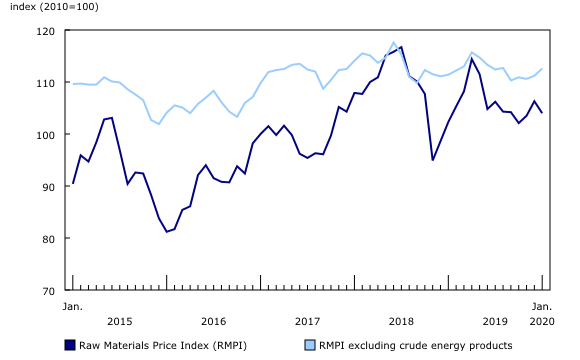Industrial product and raw materials price indexes, January 2020
Archived Content
Information identified as archived is provided for reference, research or recordkeeping purposes. It is not subject to the Government of Canada Web Standards and has not been altered or updated since it was archived. Please "contact us" to request a format other than those available.
Released: 2020-02-28
Prices for products manufactured in Canada, as measured by the Industrial Product Price Index (IPPI), were down 0.3% in January, driven primarily by lower prices for energy and petroleum products. Prices for raw materials purchased by manufacturers operating in Canada, as measured by the Raw Materials Price Index (RMPI), decreased 2.2% because of lower prices for crude energy products.
Industrial Product Price Index
In January, the IPPI declined 0.3% on a month-over-month basis. The IPPI excluding energy and petroleum products was unchanged.
Energy and petroleum products (-2.6%) were the main contributor to the IPPI decline in January. Lower prices for light fuel oils (-5.5%) and diesel fuel (-4.7%) were mainly responsible for this decrease.
Higher prices for primary non-ferrous metal products (+1.7%), particularly unwrought precious metals and precious metal alloys (+4.2%), mostly offset the decline in the IPPI. This increase coincided with the escalation of tensions in the Middle East and the outbreak of the coronavirus (COVID-19).
Year over year, the IPPI rose 0.5% in January, mainly led by higher prices for energy and petroleum products (+4.9%).
Raw Materials Price Index
On a monthly basis, the RMPI fell 2.2% in January, entirely because of lower prices for crude energy products (-6.2%). Rising tensions in the Middle East led to higher prices for crude oil in early January, while fears about the coronavirus (COVID-19) brought prices down later in the month.
The RMPI excluding crude energy products rose 1.3%—mainly on higher prices for metal ores, concentrates and scrap (+1.3%), and animals and animal products (+1.2%).
Year over year, the RMPI increased 1.7% in January. Most of this gain was led by higher prices for crude energy products (+2.5%).
Note to readers
The Industrial Product Price Index (IPPI) and the Raw Materials Price Index (RMPI) are available at the Canada level only. Selected commodity groups within the IPPI are also available by region.
With each release, data for the previous six months may have been revised. The indexes are not seasonally adjusted.
The Industrial Product Price Index reflects the prices that producers in Canada receive as goods leave the plant gate. It does not reflect what the consumer pays. Unlike the Consumer Price Index, the IPPI excludes indirect taxes and all costs that occur between the time a good leaves the plant and the time the final user takes possession of it, including transportation, wholesale and retail costs.
Canadian producers export many goods. They often indicate their prices in foreign currencies, especially in US dollars, which are then converted into Canadian dollars. In particular, this is the case for motor vehicles, pulp and paper products, and wood products. Therefore, fluctuations in the value of the Canadian dollar against its US counterpart affect the IPPI. However, the conversion to Canadian dollars reflects only how respondents provide their prices. This is not a measure that takes into account the full effect of exchange rates.
The conversion of prices received in US dollars is based on the average monthly exchange rate established by the Bank of Canada and available in table 33-10-0163-01 (series v111666275). Monthly and annual variations in the exchange rate, as described in the release, are calculated according to the indirect quotation of the exchange rate (for example, CAN$1 = US$X).
The Raw Materials Price Index reflects the prices paid by Canadian manufacturers for key raw materials. Many of those prices are set on the world market. However, as few prices are denominated in foreign currencies, their conversion into Canadian dollars has only a minor effect on the calculation of the RMPI.
Products
Statistics Canada has launched the Producer Price Indexes Portal as part of a suite of portals for prices and price indexes. This webpage provides Canadians with a single point of access to a variety of statistics and measures related to producer prices.
The video "Producer Price Indexes" is available on the Statistics Canada Training Institute webpage. It provides an introduction to Statistics Canada's producer price indexes—what they are, how they are made and what they are used for.
Real-time table
Real-time table 18-10-0248-01 will be updated on March 9.
Next release
The industrial product and raw materials price indexes for February will be released on March 31.
Contact information
For more information, or to enquire about the concepts, methods or data quality of this release, contact us (toll-free 1-800-263-1136; 514-283-8300; STATCAN.infostats-infostats.STATCAN@canada.ca) or Media Relations (613-951-4636; STATCAN.mediahotline-ligneinfomedias.STATCAN@canada.ca).
- Date modified:





